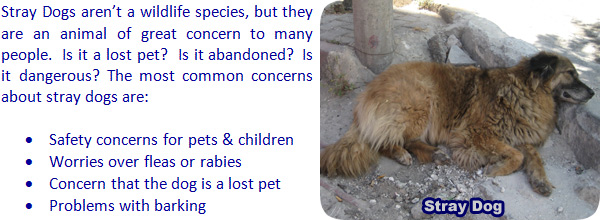- info@wildlifeanimalcontrol.com
Call us for help in your town
Wildlife Control Education
Stray Dog Information & Facts

Need stray dog removal in your hometown? We service over 500 USA locations! Click here to hire us in your town and check prices - updated for year 2020.
In addition to the below general information about stray dogs, I've also written these helpful articles. Learn how to Catch a Stray Dog, whether or not you should Feed a Stray Dog, and how to Adopt a Stray Dog. Learn the 10 most common Problems Caused By Stray Dogs, and how to Protect Yourself against dangerous stray dogs. Learn what to do if you are Bitten by a Stray Dog, and even how to stop your neighbor's dog From Barking.
Stray Dog Appearance: There is no specific color, height, or weight for a stray dog. Dogs come in every shape and size, and the only factor that separates a stray dog from a house dog is the small issue of ownership. All canines, barring those few who bear genetic mutations, are born with four legs. Beyond that, there is little in the way of similarity. Dogs can have long snouts, short snouts, or can be brachycephalic. They can have bulging eyes or beady eyes. Ears can be long and hairy or tall and upright. A dog’s body can be short, long, compact, or spindly. Tails—bushy, curly, or missing—all depend on the pedigree of the animal. The main identifiers for a stray dog are the animal’s outward body condition. A stray animal will likely be emaciated with visible bone structure or grotesque bloated abdomen, though pot-bellies are indicative of a parasite overload and not a sign of proper diet. The hair coat of a stray dog will be unkempt and likely filthy. Longer haired animals will be covered in mats and tangles. Some breeds will have a build-up of eye or nasal discharge. A stray dog’s nails may be so long they have grown into the foot pad. All in all, a general appearance of neglect will accompany a stray dog.
Stray Dog Habitat and Behavior: A stray dog can live almost anywhere people live. In rare instances, stray dogs may join coyote packs. Wolves are less tolerant of dogs and will likely kill a stray that enters the pack territory. Stray dogs live on the outskirts of humanity and because of this they are usually leery and mistrustful of humans. Stray dogs within a town or city will live anywhere they can. Like all other animals, they want to be dry and safe in a relatively quiet area. This instinct for protection makes the underside of decks and porches ideal areas for a stray dog to live. These canines have been known to crawl into drain pipes and sewers to find adequate living space. More often than not, a stray dog will be nomadic, rarely finding a location that is safe for a long period of time.
Canine camaraderie is not uncommon in stray dogs. In large areas with innumerable strays, packs can form. A pack of stray dogs will have a hierarchy similar to that of wolves, with the alpha dog directing the pack’s movements around the neighborhood. Stray dogs are less stringent on the roles of male versus female in the alpha position. Any dog of any sex can hold the position until another challenger ousts them.
Because many of the stray canines in the world were once owned, a number of them are sterilized. Those that can breed are able to do so as often as every four months. Dogs can breed at any time of the year. Litter size depends on the breed but can have as many as fourteen puppies.
Stray Dog Diet: Dogs are widely thought of as carnivorous, but they are not beholden to a need for a protein-only diet. A stray dog will eat almost anything a human might classify as edible, including vegetables, candy, fruit, or fast food. The most important factor in diet is the smell of the item. A sweet-smelling bowl of sugared fruit will be more enticing than a garden-fresh piece of broccoli. When desperate, stray dogs will often eat plastic containers that smell like food.
Stray Dog Nuisance Concerns: Strays pose a serious threat to both humans and household pets. A stray dog is ranked high on the list of rabies carriers due to the canine’s undiscerning palate which may lead to consumption of a rabies-infected mammal. Stray dogs are often fearful of humans. This fear can lead to serious physical injury if the dog is cornered of feels threatened. House pets are often victims in scuffles with stray dogs, and organized packs will hunt domestic animals inside yard enclosures. Homeowners also worry about cleaning up garbage strewn through the streets after a stray dog has wandered through.
Stray Dog Diseases: Rabies is a real fear when it comes to a stray dog. If affected, the animal will most likely exhibit neurologic symptoms: unsteady gait and irregular eye movements. An excess of saliva may be visible around the lips. Stray dogs can also carry leptospirosis, pasteurella, capnocytophaga, and brucella. Children are especially susceptible to infection from intestinal parasites found in dog stool. Many of these parasites can live in a yard for years after initial infestation.
This site is intended to provide stray dog education and information, so that you can make an informed decision
if you need to deal with a stray dog problem. This site provides many stray dog control articles and strategies, if
you wish to attempt to solve the problem yourself. If you are unable to do so, which is likely with many
cases of stray dog removal, please go to the home page and click the USA map, where I have wildlife removal experts
listed in over 500 cites and towns, who can properly help you with your nuisance stray dog.

















